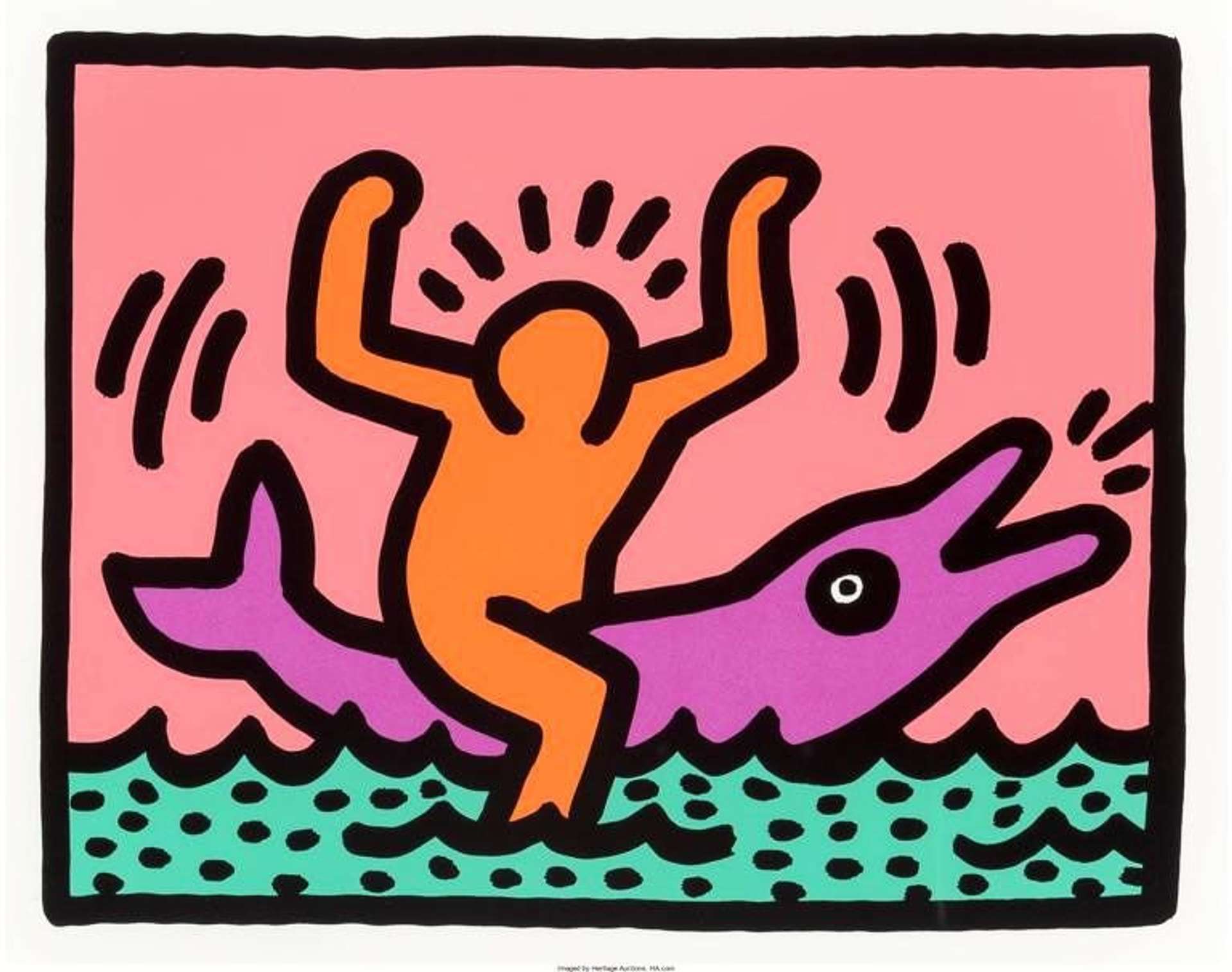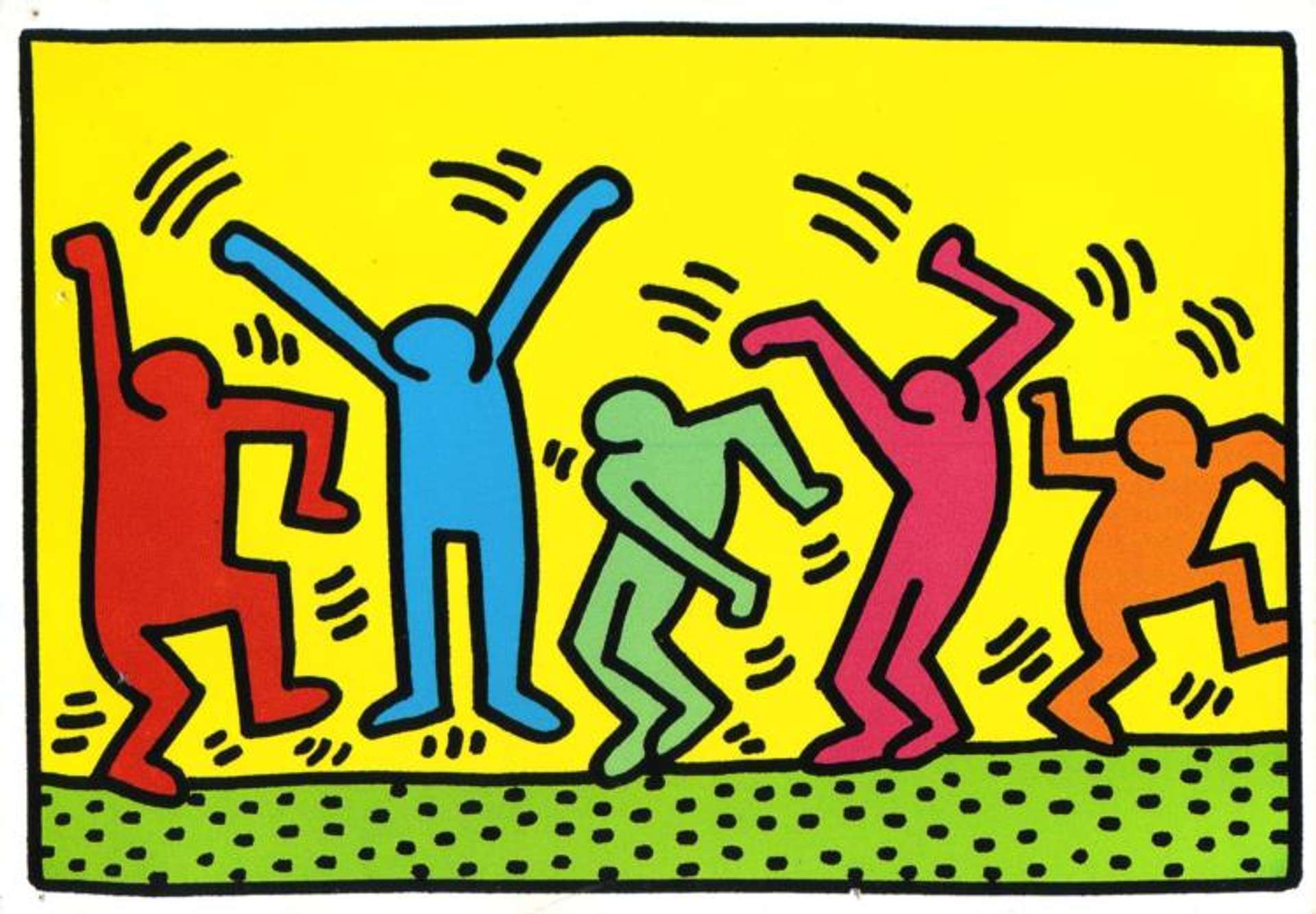Keith Haring and Vivienne Westwood

 Image © Kerry Taylor Auctions / A Vivienne Westwood and Keith Haring Witches collection 'Smiley face' knitted top, Autumn/Winter 1983-4
Image © Kerry Taylor Auctions / A Vivienne Westwood and Keith Haring Witches collection 'Smiley face' knitted top, Autumn/Winter 1983-4
Interested in buying or selling
Keith Haring?

Keith Haring
249 works
Although Keith Haring’s imagery is now ubiquitous in pop culture and streetwear, Vivienne Westwood and Malcolm McLaren were the first to put his art on the runway, a remarkable fusion of art and fashion. This partnership showcased the dynamic interplay between Haring's graffiti-inspired artwork and Westwood's avant-garde designs, but also captured the spirit of an era marked by bold experimentation and social commentary.
Keith Haring: A Pioneer in Artistic Expression
Haring emerged as a pioneering figure in the art world during the early 1980s, becoming synonymous with the vibrant, socio-political landscape of the time. His work is characterised by bold lines, vivid colours, and dynamic iconography, often conveying messages of love, peace, equality, and unity. Haring's art is also unique for its blending of street culture, activism, and Pop Art, making it both accessible and deeply meaningful.
Born in 1958 in Reading, Pennsylvania, Haring was drawn to art from an early age; move to New York City in 1978 truly ignited his career in the field. Immersing himself in the city's street culture, Haring began to use public spaces as his canvas, drawing chalk outlines on empty advertising panels in subway stations. These early works quickly garnered public attention and became a hallmark of his approach to bringing art to a wider audience. Beyond his subway drawings, Haring took on larger scale works, including murals across the world. Haring's work was deeply embedded with activism: he tackled issues such as apartheid, the crack cocaine epidemic, the AIDS crisis, which he was personally affected by. His imagery, often featuring dancing figures, barking dogs, and flying saucers, was visually striking and rich with symbolism and commentary on social issues.
Haring's collaboration with like-minded creatives, including his iconic partnership with fashion designer Westwood, further demonstrated his commitment to merging art with everyday life. Through such collaborations, Haring extended his artistic influence into the realms of fashion and consumer culture, making a profound statement on the accessibility and inclusivity of art. His work in the Pop Shop was a frontrunner in the history of making art commercially accessible, a legacy that his Estate continues to this day.
Despite his career being tragically cut short by AIDS in 1990 at the age of 31, Haring's impact endures. His foundation continues to support children's programs and organisations dedicated to AIDS awareness and education. Haring's work remains a powerful example of art as a vehicle for social change, embodying the spirit of activism and the power of visual communication to engage, educate, and inspire.
 Image © Creative Commons via Flickr UK in France / Vivienne Westwood unveils new collection at British Ambassador's Residence in Paris 2013
Image © Creative Commons via Flickr UK in France / Vivienne Westwood unveils new collection at British Ambassador's Residence in Paris 2013Vivienne Westwood: The Queen of Punk Fashion
Westwood is often hailed as the Queen of Punk Fashion, a seminal figure in the world of fashion known for her indelible influence on the punk rock movement and its associated aesthetic. Born on April 8, 1941, in Derbyshire, England, Westwood's journey into fashion was not straightforward. Initially, she worked as a primary school teacher while designing jewellery on the side. Her foray into fashion design began in earnest when she met Malcolm McLaren, the future manager of the punk band the Sex Pistols. In the 1970s, Westwood and McLaren opened a boutique on King's Road in London, initially named "Let It Rock" and later known as "SEX." This store became a cultural hub for the burgeoning punk scene, offering clothing that was provocative, rebellious, and deeply connected to the music and ideologies of punk. Westwood's designs—characterised by torn fabric, safety pins, bondage gear, and provocative slogans—challenged conventional norms of fashion, embodying the spirit of rebellion and anti-establishment sentiments of the punk movement.
Over the decades, Westwood demonstrated a remarkable ability to evolve, incorporating historical references and traditional British elements into her work, all while maintaining an edge of rebellion. Her collections explored themes from pirates to witches, and from English Civil War to climate change, showcasing her wide-ranging interests and commitment to political activism. Her fashion shows were known for their theatricality and social commentary, often reflecting her environmental advocacy and criticism of consumer culture. Her personal activism was an integral part of her brand, and she was involved in campaigns related to climate change, civil rights, and anti-war movements. For this, Westwood received numerous accolades for her work, including being named a Dame by Queen Elizabeth II in 2006 for her services to fashion. Her designs have been worn by celebrities, musicians, and royalty, further cementing her status as a fashion icon. She died in London on 29 December 2022, aged 81.
 Image © 1stDibs / Museum World's End Vivienne Westwood 'Witches' Collection (Keith Haring) 1983
Image © 1stDibs / Museum World's End Vivienne Westwood 'Witches' Collection (Keith Haring) 1983The Haring-Westwood Collaboration
Although Haring’s imagery is now ubiquitous in pop culture and streetwear, Westwood and McLaren were the first to put his art on the runway. The Haring-Westwood collaboration on the "Witches" collection for Autumn/Winter 1983 stands as a landmark moment in fashion history, marking the final joint effort between Westwood and McLaren. Its inception followed a pivotal trip to America where they met Haring, who contributed his distinctive designs to several pieces within the collection, embedding his fluorescent, public art motifs into high fashion. Haring’s symbols and characters, imbued with social and political messages, offered a striking visual language that perfectly complemented Westwood and McLaren's disruptive, punk ethos.
The collection drew heavily on early-1980s American hip-hop culture, a movement that was being championed by McLaren through his own work, notably his solo album "Duck Rock." This album, which also featured artwork by Haring, was instrumental in popularising hip-hop in the UK and underscored the cultural cross-pollination that characterised the collaboration. The "Witches" collection was not just a showcase of fashion but a multimedia experience, presented on the catwalk with strobe lighting, creating a disorienting, freeze-frame effect that accentuated the movement and dynamism of the designs. Accompanied by a soundtrack of rap music, the presentation was a celebration of hip-hop culture, melding it with high fashion in a way that was groundbreaking at the time.
The collaboration between Haring, Westwood, and McLaren was more than just a merging of their individual talents; it was a confluence of their shared interests in art, activism, and cultural commentary. The "Witches" collection, with its references to hip-hop, graffiti art, and esoteric symbols, was a vivid expression of this synergy. It encapsulated the spirit of the era, characterised by a defiance of convention and a blurring of the boundaries between art forms.
 Image © V&A / Jacket © Keith Haring and Vivienne Westwood 1985
Image © V&A / Jacket © Keith Haring and Vivienne Westwood 1985Iconic Pieces from the Haring-Westwood Partnership
The Haring-Westwood partnership produced several iconic pieces that perfectly encapsulate the fusion of art and fashion, Some of these include: A towelling shirt with rubberised Haring 'Barking Dog' print, which is particularly noteworthy for its innovative design and the use of Haring's iconic symbol. The shirt features an asymmetric cut enhanced by pinstriped cotton insertions at the underarms, showcasing Westwood's knack for disrupting traditional tailoring with unexpected elements; A printed V-Neck that combines the comfort and casual style of a sweatshirt with the distinctive artistry of Haring; A man's jacket made of printed sheepskin, which is adorned with Haring's print, marrying the luxury and texture of sheepskin with the dynamic energy of his designs; A matching knit skirt and jumper set with neon Haring motifs against a black background, reflecting the 1980s fashion trend of coordinated outfits and neon
Each piece from the Haring-Westwood partnership reflects the individual strengths of the artist and designer while serving as a bridge between two creative worlds, bringing together the immediacy and social engagement of street art with the craftsmanship and innovation of high fashion. These iconic pieces stand as enduring symbols of a collaboration that challenged conventions and redefined the possibilities of fashion as a platform for artistic expression.
 Image © 1stDibs / Matching knit skirt suit set 1984
Image © 1stDibs / Matching knit skirt suit set 1984Cultural Significance: What the Collaboration Meant for the 80s
At its core, the partnership between Haring and Westwood was emblematic of a period characterised by bold experimentation, the breaking down of barriers between high and low culture, and a growing dialogue between different creative disciplines. The Haring-Westwood collaboration heralded a new era where the integration of art and fashion became a standard practice, paving the way for countless future collaborations between artists and fashion designers. This partnership demonstrated the potential for such to enrich both disciplines, offering artists a new avenue for expression and enabling fashion designers to elevate their creations beyond the realm of clothing to that of conceptual art.
For Haring, the collaboration served as a crucial platform that propelled his work into the wider public consciousness, enabling his art to reach a broader audience beyond the galleries and streets of New York. By embedding his distinctive motifs into Westwood's designs, Haring's art became wearable, accessible, and – very importantly – commercial. This move towards the commercialisation of art was a defining feature of the 1980s, and Haring's participation in this collaboration underscored his belief in art as a democratic medium, one that could and should be experienced by as many people as possible.
The cultural significance of this collaboration also lies in its contribution to the defining aesthetic of the decade; it captured the spirit of an era marked by a vibrant youth culture, the rise of hip-hop, and a growing awareness of social and political issues. Haring and Westwood's work, imbued with messages of activism and social commentary, resonated with a generation eager for change, making their collaboration not just a fashion statement but a cultural commentary. This partnership set a precedent for the role of fashion as a platform for social and political engagement, inspiring future generations of designers and artists to use their work as a means of commentary and change. It showcased the power of collaboration to challenge societal norms, encourage dialogue, and foster innovation.





